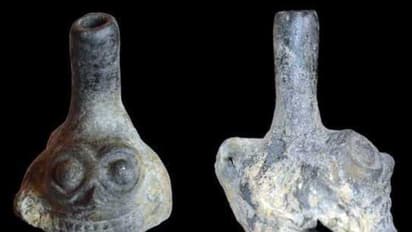'Scariest sound in the world': Ancient Aztec Death Whistle still terrifies people, reveals study (LISTEN)

Synopsis
The bone-chilling wail of the Aztec Death Whistle- a sound once believed to herald the end for human sacrifices- continues to send shivers down spines, even 500 years later.
The bone-chilling wail of the Aztec Death Whistle- a sound once believed to herald the end for human sacrifices- continues to send shivers down spines, even 500 years later. Described as “the scream of a thousand corpses” or a spectral gust of wind, this sound has been scientifically proven to invoke a visceral, primal response in modern listeners.
According to Daily Mail, a recent study conducted by researchers at the University of Zurich delved into the psychological and neural effects of this haunting sound. Participants exposed to the whistle reported overwhelming fear, with brain scans revealing heightened activity in regions tied to core emotions such as terror, grief, and rage.
"The sound is rough and high-pitched, and as listeners, you usually do not like such sounds," explained lead researcher Professor Sascha Fruhholz.
The unsettling device, often referred to as the Skull Whistle, dates back to between 1250 and 1521 AD. These instruments, frequently found in ancient Aztec burial sites, have long baffled archaeologists due to their eerie skull-like design.
Their purpose was revealed only after an inquisitive researcher dared to blow into one, unleashing a cacophonous wail reminiscent of a human scream.
Archaeologists theorize that the Aztecs used these whistles to evoke fear—whether to terrify enemies in battle or to amplify the dread surrounding human sacrifice rituals. The research team tested this hypothesis by exposing European volunteers to recordings of genuine and replica Death Whistles, alongside various other sounds.
The results were striking. Universally, the whistle evoked a powerful emotional reaction, likened to the urgency of gunfire, the shriek of sirens, or the anguished cries of pain.
“Since the Aztec skull whistle sounds close to a human scream, we wanted to investigate if humans have the same negative and aversive response to Aztec death whistle sounds,” added Professor Frühholz.
The study, published in Communications Psychology, found that the Death Whistle's unique sound profile—characterized by "noisy and rough" tones—mirrors the alarming cries of primates and even elements of "terrifying music." This effect is further amplified by its mimicry of human speech and shouts, triggering an instinctive reaction in listeners.
Participants frequently described the sound as resembling both natural and mechanical noises, including screams, kettles, chainsaws, and trains. This unusual blend of organic and artificial tones left their brains momentarily confused and disoriented, likely amplifying the whistle's fear-inducing power.
The Aztecs may have harnessed this psychological impact to paralyze their enemies or strike fear into audiences witnessing ritual sacrifices. Whistles have been discovered clutched in the hands of sacrificial victims at temples like Ehecatl-Quetzalcoatl in Mexico City.
Some researchers believe the whistles symbolize Mictlantecuhtli, the Aztec Lord of the Underworld, further solidifying their association with death and the macabre.
“Given both the aversive/scary and associative/symbolic sound nature as well as currently known excavation locations at ritual burial sites with human sacrifices, usage in ritual contexts seems very likely,” concluded Professor Frühholz and his team.
Check the Breaking News Today and Latest News from across India and around the world. Stay updated with the latest World News and global developments from politics to economy and current affairs. Get in-depth coverage of China News, Europe News, Pakistan News, and South Asia News, along with top headlines from the UK and US. Follow expert analysis, international trends, and breaking updates from around the globe. Download the Asianet News Official App from the Android Play Store and iPhone App Store for accurate and timely news updates anytime, anywhere.